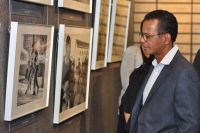
Contributing photographer Jimi Matthews at the launch of Between States of Emergency
Painful and triumphant memories of South Africa’s apartheid years hang on the walls of the Nelson Mandela Foundation in a new photographic exhibition titled, Between States of Emergency.
The exhibition will remain at the Foundation until mid-March 2016 and can be viewed by appointment.
It honours photographers who defied martial law to expose the brutality of apartheid during the two States of Emergency imposed in the 1980s, risking their lives and personal freedom to share the atrocities taking place here with the rest of the world.
It captures South Africa’s political landscape from 21 July 1985 to 7 June 1990, and the apartheid government’s frenzied and increasingly unsuccessful attempts to quell political dissent.
Within the first six months, 575 people were killed in the resulting unrest – more than half of that number at the hands of police officers.
National and international news coverage of protests was forbidden, curfews were imposed, political funerals banned, and over 26 000 activists and innocent bystanders detained.
And while Between States of Emergency shows the heartbreak of racial oppression, it also captures the triumph in small victories won – embracing a loved one finally released from an unjust prison sentence – or the defiance and bravery shown in facing down the enemy.
Lucia Raadschelders, an archivist at the Foundation, recalls seeing these images for the first time while working with the Anti-Apartheid Movement in the Netherlands, and the drastic impact they had.
“During the states of emergency, which became heavier and heavier as time went on, it was almost impossible for photographers from other countries to come into South Africa and expose what was happening. These photos were sent out of the country illegally to the rest of the world.
“It’s hard to measure what a great impact the work of these photographers had in the fight against apartheid. It has always stayed with me.”
Each photographer, among them the likes of Peter Magubane, Alf Kumalo and David Goldblatt, handpicked two images from their vast portfolios and expressed their personal recollections of each.
They risked beatings, teargasing, arrest, heavy fines and prison sentences to show the world the truth. Often these were unavoidable. Magubane would hide his camera in a hollowed-out piece of bread or a milk carton to avoid the wrath of police, but was still beaten and detained during his career, like many others.
“Activist or not, people working in the alternative media are entitled to recognition as professionals,” said journalist, author and political activist Rehana Rossouw, who gave the keynote address at the launch of Between States of Emergency. Rossouw was also detained while covering this period in South Africa’s history.
“They may have been a bit deeper in the trenches, a bit more heartbroken by state violence unleashed on people clamouring for freedom, and paid a lot less when they worked for the alternative press, but they went out onto the streets, day after bloody day, recording the truth that the state’s lies could no longer conceal.
“I salute the Nelson Mandela Foundation for also giving these photographers the recognition they deserve.”
ENDS
Media Enquiries:
Neeran Naaidoo
+27 82 994 0349